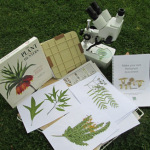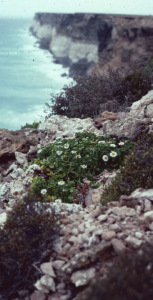![]() Since this weekend, the Journal of the Adelaide Botanic Gardens is available on the JSTOR shared digital library. JSTOR is a subscription-based online library of scholarly content, to which the majority of Australian and overseas university and institutional libraries subscribe. Our presence on JSTOR is in addition to free access through the Journal’s web-page and EnviroDataSA, and strengthens the Journal’s presence in libraries worldwide. This means also that our Journal is now more easily accessible to many researchers and will automatically appear in library catalogues of universities and other institutions, who subscribe to the service. Continue reading
Since this weekend, the Journal of the Adelaide Botanic Gardens is available on the JSTOR shared digital library. JSTOR is a subscription-based online library of scholarly content, to which the majority of Australian and overseas university and institutional libraries subscribe. Our presence on JSTOR is in addition to free access through the Journal’s web-page and EnviroDataSA, and strengthens the Journal’s presence in libraries worldwide. This means also that our Journal is now more easily accessible to many researchers and will automatically appear in library catalogues of universities and other institutions, who subscribe to the service. Continue reading
Author Archives: Jürgen
State Herbarium celebrations
 This week, on 9 Dec. 2014, over 90 current and former staff members, volunteers, plant collectors, State Herbarium friends and other guests gathered in the National Wine Centre of Australia to celebrate the 60th anniversary of the State Herbarium of South Australia. This also launched a year of celebrations, with other functions, seminars and talks being planned for 2015.
This week, on 9 Dec. 2014, over 90 current and former staff members, volunteers, plant collectors, State Herbarium friends and other guests gathered in the National Wine Centre of Australia to celebrate the 60th anniversary of the State Herbarium of South Australia. This also launched a year of celebrations, with other functions, seminars and talks being planned for 2015.
The State Herbarium was established in 1954 by bringing together several different herbaria from The University of Adelaide, the South Australian Museum and other private and institutional collections. With about 1.035 million specimens, it is now one of the largest herbaria in Australia.
The Celebrations started with an acknowledgment of the Aboriginal inhabitants of the Adelaide area by State Herbarium Manager Peter Canty. This was followed by Helena Jenkinson from the Board of the Botanic Gardens and State Herbarium, who welcomed everyone to the function. Chief Botanist Prof. Michelle Waycott, then spoke about the history of the State Herbarium and its function today. Continue reading
New Journal volume, Dec. 2014
Today, 1 Dec. 2014, a new special volume of the Journal of the Adelaide Botanic Gardens was published. Volume 28 of the Journal consists of one article: P.S. Short’s magnum opus, the revision of the Australian species of Brachyscome (Asteraceae).
A taxonomic review of Brachyscome s.lat. (Asteraceae: Astereae), including descriptions of a new genus, Roebuckia, new species and new infraspecific taxa. (10mb PDF)
The 219 page article is the result of over 20 years’ of research. All Australian species of Brachyscome and related genera are reviewed. 17 new species and 4 subspecies of Brachyscome are described as new, totalling the number of species of the genus to 87. The new genus Roebuckia is split from Brachyscome. It is named after William Dampier’s ship, the Roebuck, which landed on the W.A. coast in 1699. Roebuckia contains 9 species, of which 5 species are new described, as well as 5 new varieties.
The paper is illustrated with photographs and very detailed line-drawings of fruits by botanical artist Sue Wickison from New Zealand. The articles concludes with a large appendix, listing the character states for 87 morphological and other characters for all species discussed.
To access content of all volumes of the Journal of the Adelaide Botanic Gardens since 1976, please visit the journal’s web-site at flora.sa.gov.au/jabg.
Mundulla Primary School Herbarium Project
 Please note that Dee Provis’ seminar about the Mudalla Primary School Herbarium Project has been shifted from next Tuesday
Please note that Dee Provis’ seminar about the Mudalla Primary School Herbarium Project has been shifted from next Tuesday
to Monday, 15 December 2014, 2:00pm–3:00pm.
The talk will now take place in the afternoon.
Detailled information about this It’s all about the plants talk can be found here.
Soil seed banks and the restoration of plant biodiversity in an arid zone habitat
It’s All About the Plants
Tuesday, 25 November 2014, 10:00–12:00
Ground Floor Meeting & Lunch Room, Tram Barn
by Molly Whalen, Rick Davies & Alison Nicolson
Flinders University School of Biological Sciences
 Predicting the response of native vegetation in Australia’s arid rangelands to management actions, such as changing grazing regimes, is often hampered by a lack of knowledge regarding the nature of native plant biodiversity at a local scale. Simply measuring above-ground plant species richness can be quite misleading because in arid habitats, much of a site’s plant diversity, particularly that of short-lived species, may be present as dormant seeds in the soil seed bank. We are investigating factors influencing variation in both above- and below-ground plant diversity in a large (ca. 420,000 km2) conservation reserve in arid South Australia. This reserve, Witchelina, has a long history (ca. 140 years) of pastoral use, but was destocked in 2010 when it was purchased by the Nature Foundation of South Australia. Particular factors being investigated include variation among different habitats and effects of past grazing intensities. For example, we are comparing the diversity and composition of the seed banks and above-ground vegetation in areas close to watering points with a history of heavy grazing with those of areas more distant from watering points that have been less heavily grazed. Alison Nicolson will also speak about her honours research on Witchelina, for which she used existing DEWNR photopoints monitoring sites at Witchelina to study regeneration since 1999. By comparing, photopoint photos taken in 2014 with field measurements, she has also been able to evaluate the reliability of using photopoints alone as a monitoring tool.
Predicting the response of native vegetation in Australia’s arid rangelands to management actions, such as changing grazing regimes, is often hampered by a lack of knowledge regarding the nature of native plant biodiversity at a local scale. Simply measuring above-ground plant species richness can be quite misleading because in arid habitats, much of a site’s plant diversity, particularly that of short-lived species, may be present as dormant seeds in the soil seed bank. We are investigating factors influencing variation in both above- and below-ground plant diversity in a large (ca. 420,000 km2) conservation reserve in arid South Australia. This reserve, Witchelina, has a long history (ca. 140 years) of pastoral use, but was destocked in 2010 when it was purchased by the Nature Foundation of South Australia. Particular factors being investigated include variation among different habitats and effects of past grazing intensities. For example, we are comparing the diversity and composition of the seed banks and above-ground vegetation in areas close to watering points with a history of heavy grazing with those of areas more distant from watering points that have been less heavily grazed. Alison Nicolson will also speak about her honours research on Witchelina, for which she used existing DEWNR photopoints monitoring sites at Witchelina to study regeneration since 1999. By comparing, photopoint photos taken in 2014 with field measurements, she has also been able to evaluate the reliability of using photopoints alone as a monitoring tool.
All Herbarium staff, honoraries, volunteers, students and guests welcome.
Morning tea provided.


You must be logged in to post a comment.